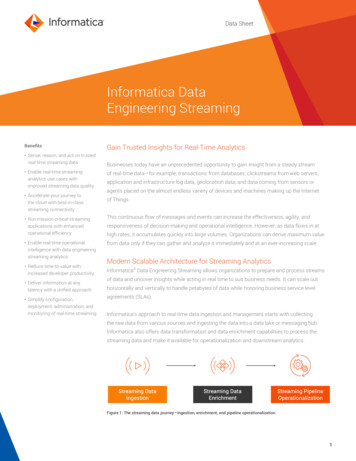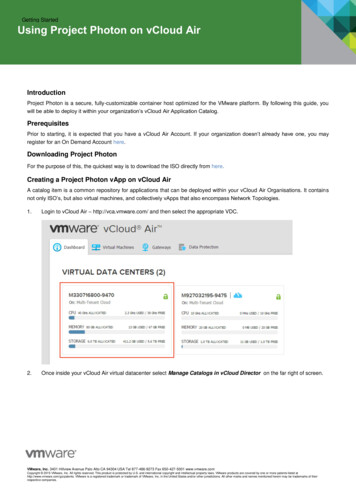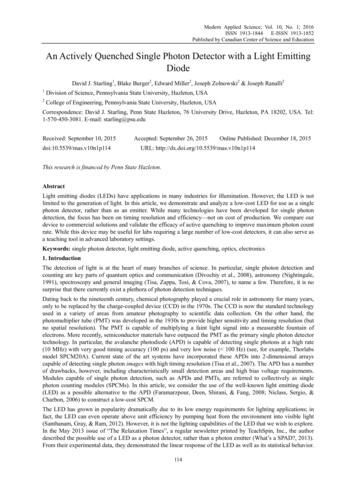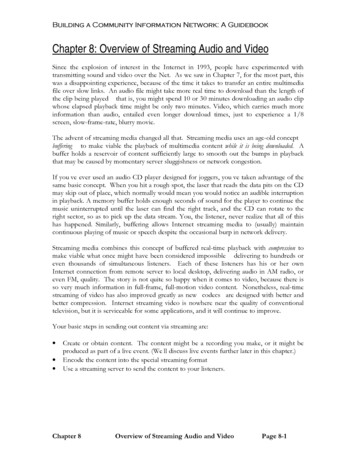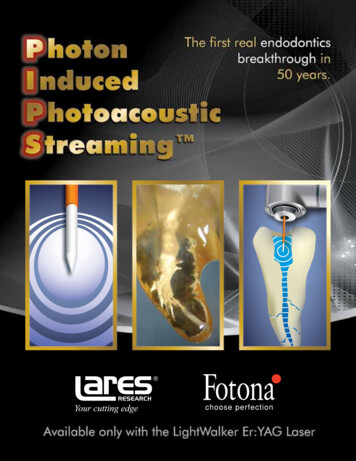
Transcription
Photon Induced PhotoacThe first real breakthroughWhat is PIPS ?PIPS (patent applied for) is a revolutionarymethod for chemically cleaning and debriding theroot canal system using Er: YAG laser energy atsub-ablative power levels.SHEATH STRIPPEDAWAYSHEATHTAPERED TIPThe stripped and tapered PIPS tip (patent appliedfor) optimizes the propagation of shock waves atsub-ablative laser power.The PIPS tip is inserted into only the coronal1/3 of the Canal.How does PIPS work?PIPS harnesses the power of the Er:YAG laser tocreate photoacoustic shock waves within the cleaningand debriding solutions introduced in the canal. Thecontainment of the shockwaves thoroughly streamsthese solutions through the entire canal system,enhancing their effectiveness. The canals and subcanals are left clean and the dentinal tubules arefree of smear layer. PIPS is equally effective forfinal water rinsing prior to obturation.
coustic Streaming (PIPS )in endodontics in 50 years.How is PIPS applied duringroot canal therapy?3. Perform PIPS with the LightWalkerPIPS is performed with the LightWalker and Lares’exclusive protocol using 15% EDTA and NaClOthen water to flush the canal system clean.1. Gain access to the canalOpen with the LightWalker Er:YAG laser as younormally would prior to root canal therapy.4. Obturate the canalObturate the canal as you normally would.PIPS is perfect for use with advancedendodontic filling resins such as EndoREZ byUltraDent . You are now ready to complete yourrestoration.2. Instrument the canal to ISO #20Instrument the canal as you normally would butstop at ISO #20, it isn’t necessary to removeany additional tooth structure, which preservestooth strength.1234
The exclusive advantages of PIPS for you and your patients1. The entire root canal and sub-canal system ismore effectively cleaned and debrided than withtraditional instrument-only techniques, reducingthe risk of re-infection.2. The minimally invasive nature of PIPS preservesmore tooth endoskeleton than traditionalinstrument techniques since filing is limited toa maximum size ISO #20, maintaining morepost-restoration tooth strength.3. Sub-ablative power levels eliminate the risks ofledging and demineralization inherent to otherlaser endodontic methods.4. Since the PIPS tip is inserted into only thecoronal 1/3 of the canal, there is no risk oftip breakage from curved canals or unwantedapical extrusion of chemical irrigants possiblewith other laser endodontic methods.5. Less filing time and less soaking time forchemical agents saves 20-30 minutes per canalfor patient and clinician.
SEM photos demonstrate theeffectiveness of PIPS Smear layer around opening of lateralcanal has been removedAOpen dentinal tubuleswith minimal smear layerBClean dentinal canal wallsCD-E. Canal wall collagen fibers and internal hydroxyapatite matrices intact and visibleDE
What makes the LightWalker Er:YAGperfect for PIPS ?LightWalkerThe LightWalker Er:YAG laser energyis uniquely suited for optimumperformance of PIPS because:1. Of the two Erbium laserwavelengths used in dentistry,Er:YAG laser energy has thehighest absorption rate in water.2. The super short, 50microseconds pulse durationavailable on the LightWalker,combined with the efficientdesign of the PIPS tip, allowsthe lowest possible energy perpulse (millijoules) and repetitionrate (hertz), minimizing thermaleffects and maximizing thepropagation of the PIPS shockwaves.3. Sub-ablative power levelseliminate the risks of ledgingand demineralization.
The development of PIPS PIPS was developedby Dr. Enrico DiVito,along with his researchteam at Medical DentalAdvanced TechnologiesGroup, LLC (MDATG)with assistance fromDr. Mark Colonna.Patents have beenapplied for utilizing theapplication of PIPS inendodontics and otherareas of dentistry.The MDATG team of dentists, engineers andbiochemists carefully optimized the PIPS system foruse with the Lares Fotona LightWalker, the world’smost advanced all-tissue laser.Dr. DiVito is founder of the Arizona Center forLaser Dentistry and maintains both a general andcosmetic private practice in Scottsdale, Arizona.He is a clinical instructor at the Arizona School ofDentistry and Oral Health where he helped developand establish the first curriculum based laserdental program. He is a pioneer in research anddevelopment for minimally invasive laser endodonticprocedures and a member of the World ClinicalLaser Institute with Mastership status.This photo of a cleared human tooth shows acomplicated canal system thoroughly cleaned usingPIPS . This tooth had five portals of exit.
Getting started with PIPSTMPIPS with the LightWalkerTMPurchase of the LightWalker entitles you to*: Perform the PIPS (patent applied for) procedure. Attend the LightWalker Advanced Endodontics Training Course to learn to perform PIPS . Purchase replacement PIPS tips.*Purchaser will be required to execute the PIPS License Agreement prior to attending LightWalker Advanced Endodontic Training. The PIPS License Agreement limits the disclosure of confidential PIPS information. See PIPS License Agreement for details. PIPS License Agreementavailable only to purchasers of the LightWalker.Dr. Mark Colonnademonstrates PIPS during advancedendodontic training.DANGER2940 nm1064 nm650 nm20w 50 to 1000 µsec15w 100 to 650 µsec1mW CWVISIBLE AND INVISIBLE LASER RADIATIONAVOID EYE OR SKIN EXPOSURE TO DIRECTOR SCATTERED RADIATIONPROTECTIVE EYEWEAR REQUIREDCLASS IV LASER PRODUCTTo learn more about PIPS and what theLightWalker all-tissue laser can do foryour practice, contact Lares Research at1-888-333-8440, ext. 2050 today.295 Lockheed AvenueChico, Ca 95973www.laresdental.com Lares Research 70281Rev. D 11/2/10
What is PIPS ? The stripped and tapered PIPS tip (patent applied for) optimizes the propagation of shock waves at sub-ablative laser power. The PIPS tip is inserted into only the coronal 1/3 of the Canal. How does PIPS work? PIPS harnesses the power of the Er:YAG laser to create photoacoustic shock waves within the cleaning



